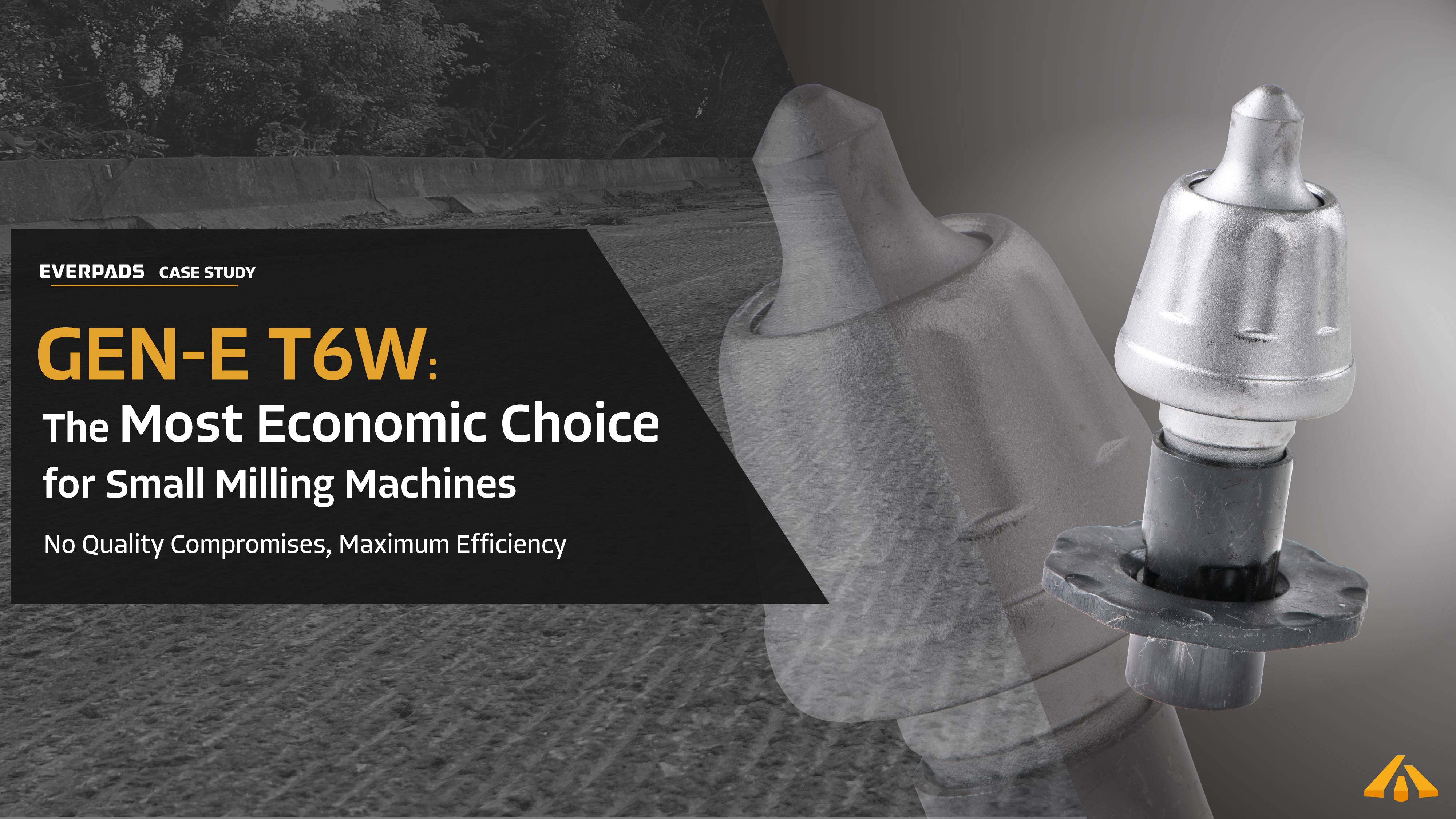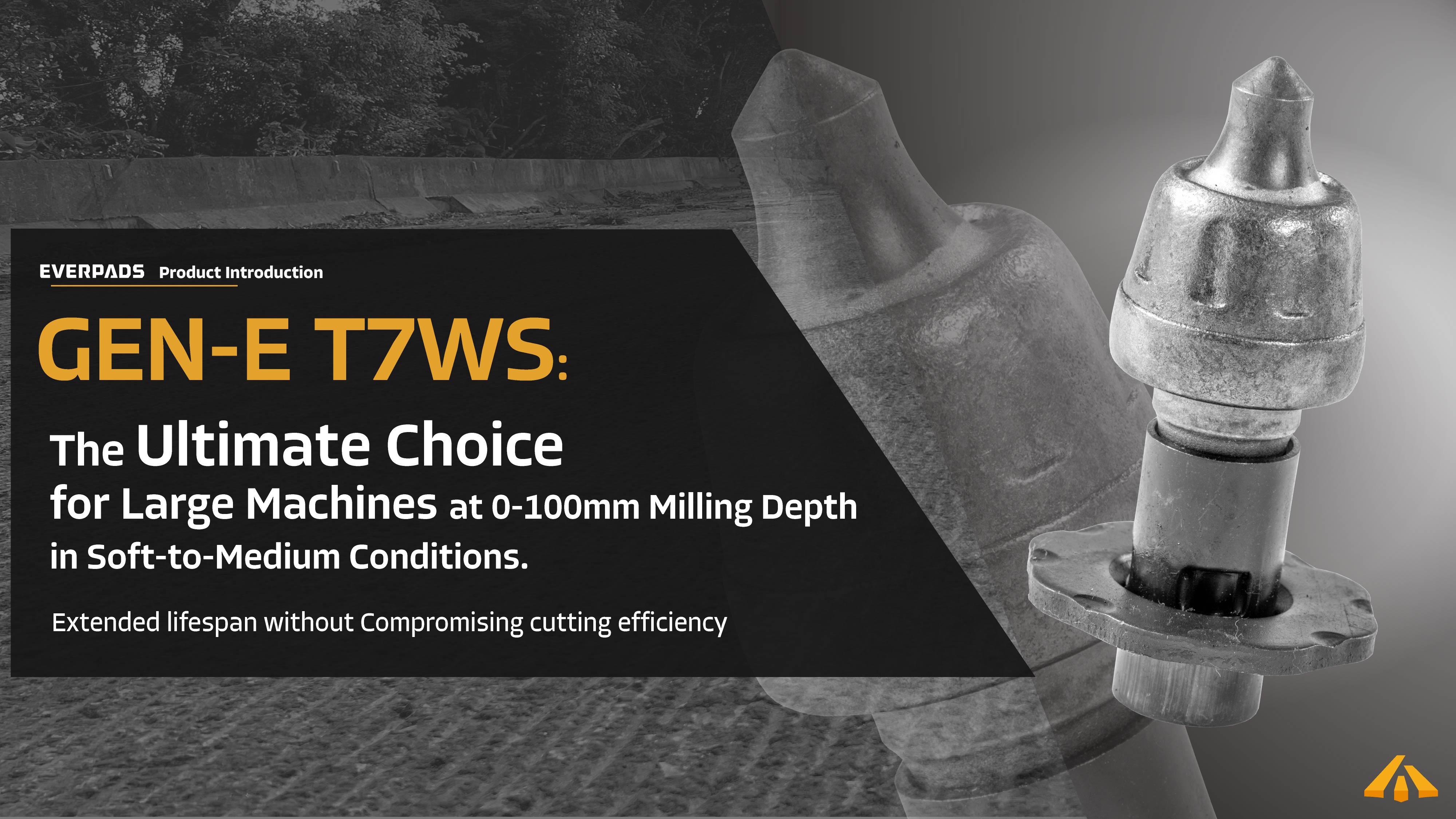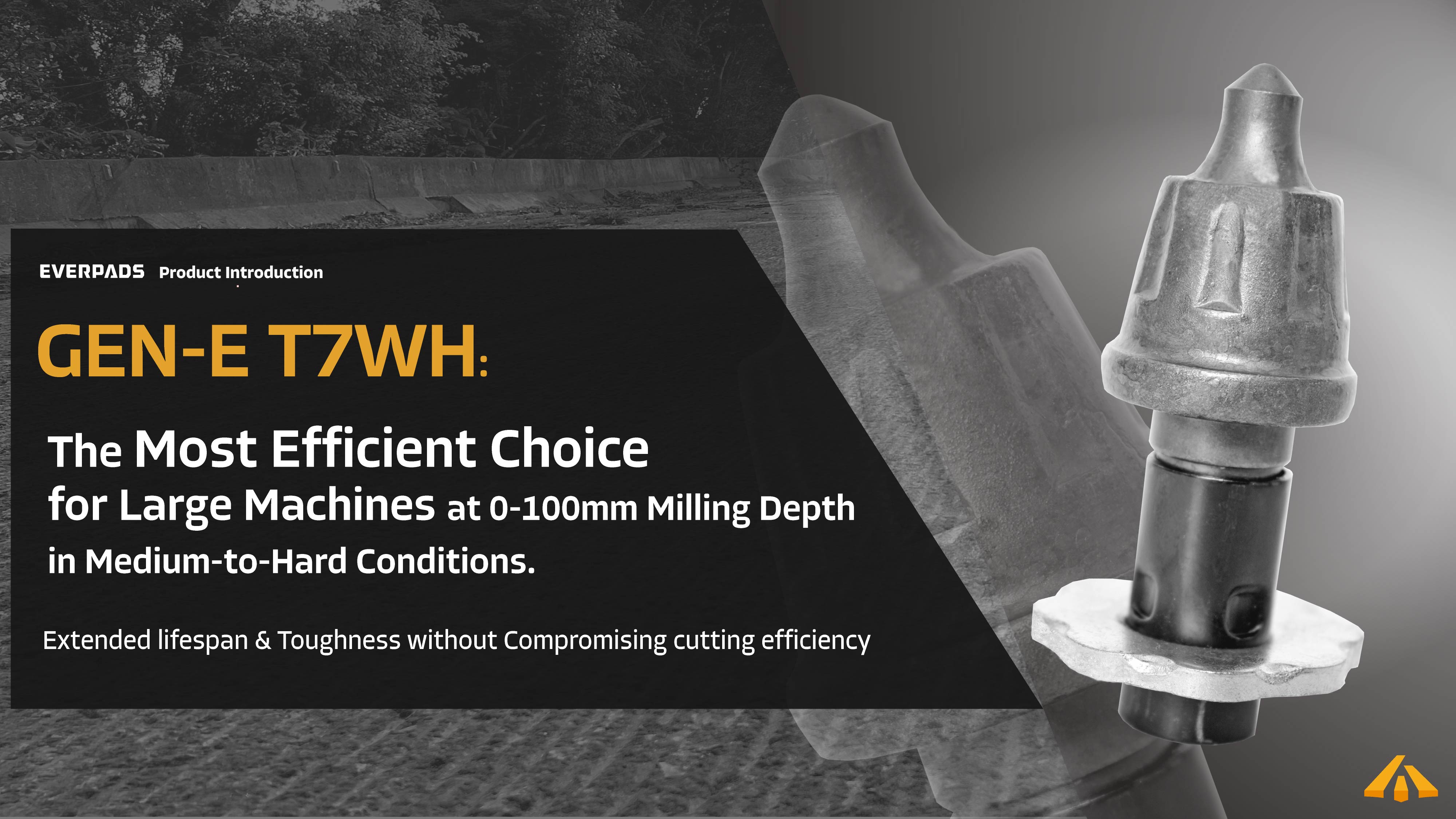Understanding the Impact of Milling Depth, Asphalt Hardness, and Machine Power on your road milling projects. Choosing the right milling teeth for your road construction project is not just about picking a product—it’s about ensuring efficiency, reducing costs, and achieving the best results for the specific conditions of your worksite. Factors such as asphalt hardness, milling depth(milling application), milling drum type(objective pattern), and milling speed play a critical role in determining the ideal teeth for your project. This guide will help you navigate these variables and make an informed decision.
This blog is perfect for:
- Dealers: Learn which teeth to recommend or assess potential suppliers.
- Contractors: Make informed decisions about upgrading or switching teeth.
You will learn:
- How asphalt surface hardness impacts milling efficiency.
- Key design features for different hardness levels.
- How to evaluate milling teeth for your needs.
Table of Contents:
1. Why is Choosing the Right Milling Teeth for Your Project's Specific Needs Crucial?
2. Key Considerations for Choosing Road Milling Teeth Based on Project Requirements
3. Teeth Design for the Different Machine Size
4. Comprehensively Choosing the Right Milling Teeth for your Project Conditions
5. Conclusion: Taking the Next StepsAdditional Information:
Learn more about how our teeth are optimized for specific conditions:
GEN-E T6W: The Most Economic Choice without Quality Compromise for Small Milling Machines
GEN-E T6WS: The Industry’s Ultimate Milling Tooth for Small Machines/ Top Economic Choice for Compact Machines
GEN-E T7WS: The Most Efficient Choice for Large Machines/Top Durability Choice for Compact Machines
GEN-E T7WH: The Top Durability Choice for Large Milling Machines/Ultimate Durability Choice for Compact Machines
I. Why is Choosing the Right Milling Teeth for Your Project's Specific Needs Crucial?
1.24_v1_CHOSSING%20THE%20RIGHT%20MILLING%20TEETH_1.png?width=11903&height=2809&name=(0)1.24_v1_CHOSSING%20THE%20RIGHT%20MILLING%20TEETH_1.png)
The success of your milling project depends on selecting milling teeth that match your specific project conditions. Incorrect choices can lead to:
- Reduced Efficiency: Teeth that aren’t optimized for the asphalt type or machine power will cut slower, increasing fuel consumption.
- Accelerated Wear: Teeth not designed for specific conditions will wear out prematurely, increasing replacement costs.
- Increased Downtime: Frequent replacements and maintenance delays project completion.
On the other hand, selecting the right teeth ensures:
- Optimal Performance: Faster cutting speeds and smoother milling results.
- Durability: Teeth last longer, reducing replacements and downtime.
- Cost Savings: Efficient operation reduces wear and energy consumption, cutting overall costs.
II. Key Considerations for Choosing Road Milling Teeth Based on Project Requirements
The primary factor influencing the design and selection of road milling teeth is milling resistance, which can be divided into:
- Individual Tooth Resistance – The force exerted on each tooth during milling.
- Overall Milling Resistance – The cumulative resistance faced by the machine.
Designs must balance these resistances to avoid tooth breakage and maintain efficiency. While this guide simplifies the complexities, real-world applications require professional adjustments.
Tooth Requirements Based on Resistance Levels
1. When Individual Tooth Resistance is High
- Hard ground material
- Greater milling depth
- Higher milling speed
- Fewer teeth on the drum
- Focus on preventing tooth breakage while maintaining milling efficiency.
- Balance is crucial, as higher strength teeth may reduce cutting efficiency.
2. When Individual Tooth Resistance is Low
- Softer surfaces or shallow milling depth
- Specialized drums (e.g., fine milling) reducing pressure on each tooth
- High tooth count
- Prioritize cutting efficiency since the risk of breakage is lower.
3. When Overall Milling Resistance is High
- High tooth count
- Deep milling or extremely hard ground material
- For deep milling or hard materials: Use high-powered machines equipped with larger, impact-resistant teeth to handle the greater load.
- For high tooth count: Opt for sharper teeth to enhance cutting efficiency and reduce overall resistance.
4. When Overall Milling Resistance is Low
- Fewer teeth on the drum
- Shallower milling depth
- For fewer teeth: Focus on preventing tooth breakage.
- For shallower milling: Use sharper teeth to improve cutting efficiency without requiring higher machine power.
Four Primary Factors Influencing Milling Resistance
1. Milling Depth (Application)
Impact:Deeper milling increases resistance, prolonging tooth-ground contact and heat accumulation.
Key Considerations:
- Use reinforced shank designs and heat-resistant materials for deep milling.
- Employ water cooling and lubrication to reduce friction and manage heat.
2. Surface Type and Hardness
Impact:Harder surfaces significantly increase resistance.
Key Considerations:
- Use specially reinforced teeth for extreme hardness (e.g., concrete).
- Opt for customized designs when standard teeth fail to meet performance needs.
3. Milling Speed
Impact:Higher speeds amplify impact forces on teeth, increasing breakage risks.
Key Considerations:
- Balance speed with tooth durability to reduce stress while maintaining efficiency.
4. Milling Drum Type (Objective Pattern)
Impact:The drum type dictates tooth arrangement and resistance distribution.
Common drum types include:
- Micro Milling: High tooth density, lower individual resistance but greater overall resistance.
- Standard Milling: Moderate resistance with higher individual tooth resistance.
- Fine Milling: Balanced resistance, requiring precise and efficient cutting.
Key Considerations:
- Adapt tooth selection based on drum type and the intended road pattern.
- Fine and micro milling often demand higher tooth counts and cutting efficiency.
Guiding Principle for Selection
While resistance is the core consideration, selecting road milling teeth should integrate all four influencing factors. Adjustments based on project-specific needs ensure the best performance and efficiency.
Important Notes
Road construction environments are complex and variable. This guide provides a general framework, but practical applications may require tailored evaluations and adjustments. Always consult with professionals to refine your choices.
III. Teeth Design for the Different Machine Size
Choosing the right carbide tips for milling depends on your machine size and the required milling depth. Larger machines handle deeper milling due to higher resistance, while smaller machines are typically limited to shallower operations. Medium and large machines provide greater flexibility for depth.
Carbide Tips Material:
- For asphalt milling, tungsten carbide is commonly used. Differences between brands lie in the crystal structure of the finished product. Within the same brand, tips designed for various applications share the same material and crystal structure. Once a brand is chosen, focus on tip dimensions to match your application.
Tip Dimensions vs. Machine Size:
- Larger tips generally offer longer lifespans and reduced breakage risk but may require higher machine power and result in lower cutting efficiency. Smaller tips enhance cutting efficiency and are more economical for softer surfaces but may limit deep milling capabilities.
Recommended Carbide Tip Dimensions
1.24_v1_CHOSSING%20THE%20RIGHT%20MILLING%20TEETH_7%20%E8%A4%87%E6%9C%AC.png)
Considering Teeth with Tips Out of the Recommended Size?
Here’s What You Need to Know:
Note 1:
Larger tips may result in poor cutting efficiency and milling texture due to limited machine power. However, increasing power and speed can improve performance with larger tips, though this may reduce machine lifespan and increase risks.
Note 2:
Smaller tips: Suitable for softer surfaces, offering better cutting efficiency and cost-effectiveness. However, they are less suitable for deep milling and may break under high resistance.
Larger tips: Ideal for deep milling and reduced breakage but less efficient, requiring higher power.
Note 3:
Select the tip dimensions based on your machine size, milling depth, and target material. Consult professionals to ensure optimal performance and cost-effectiveness for your specific project needs.
IV. Comprehensive Guide to Choosing the Right Milling Teeth for Your Project Conditions
To make it easier for readers to follow our recommendations when selecting milling teeth, we've outlined the key steps to consider:
1.24_v1_CHOSSING%20THE%20RIGHT%20MILLING%20TEETH-06-2.png?width=789&height=298&name=(0)1.24_v1_CHOSSING%20THE%20RIGHT%20MILLING%20TEETH-06-2.png)
Step 1: Identify the Milling Target (Cement or Asphalt): Use cylindrical teeth for cement; cap tips are for asphalt. If the target is cement, select cylindrical-tip teeth, as the latter is not within the scope of this discussion.
Step 2: Confirm the Recommended Teeth Range for the Machine: Refer to the recommendations provided in the previous section.
Step 3: Confirm the Type of Milling Drum: Match teeth strength and durability to the drum type and milling precision.
Why
The type of milling drum significantly affects the choice of milling teeth. Generally, for more precise drums, stronger cutting tools are recommended as they are less likely to fracture due to the distributed impact force from the increased number of teeth. Precision drums are typically used for shallower milling targets.
While tungsten carbide tips are suitable for precision drums, the large number of teeth can make replacement time-consuming and costly. For such cases, it is advisable to use specially designed tips made from ultra-durable materials that surpass traditional tungsten carbide in lifespan, thereby enhancing milling efficiency.
Step 4: Confirm the Milling Depth: Use thicker teeth for deep cuts and sharper teeth for shallow cuts.
Why
For deeper milling depths, choose thicker and broader teeth within the machine's recommended dimensions. For shallower depths, opt for sharper teeth. Selecting taller teeth can increase lifespan but may slightly reduce impact resistance.
Step 5: Confirm the Hardness of the Milling Target: Choose durable teeth for hard materials and sharper teeth for soft materials.
Why
If the target material is extremely hard and all indicators suggest a need for high-impact resistance, consider selecting thicker and more robust teeth, even if they fall outside the machine’s standard range. Conversely, for targets with low-impact resistance requirements, sharper and more economical teeth may be used.
Step 6: Consider the Milling Speed: Select thicker teeth for faster milling speeds to minimize breakage.
Why
For accelerated schedules or if the company operates at faster-than-recommended milling speeds, adjust the selected tips to slightly thicker ones based on the prior steps.
- If the priority is cost-effectiveness and the risk of early wear is acceptable, choose longer teeth of the same thickness to extend the lifespan.
- If stable lifespan is the priority, adhere to the recommendations above for consistent performance.
Note:
The above recommendations simplify the process of selecting milling teeth based on project requirements. It is essential to consult with professionals for detailed discussions. This guide is intended to help users effectively communicate their needs with experts.
V. Conclusion
Selecting the right milling teeth for your project requires a clear understanding of the machine size, milling drum type, milling depth, and asphalt conditions. Whether you’re tackling soft asphalt with low-power equipment or cutting through hard concrete with high-power machines, tailoring the teeth to your specific needs ensures maximum efficiency, durability, and cost-effectiveness.
Take the time to evaluate your project’s requirements and choose the best-suited milling teeth to optimize performance and minimize downtime.
Need help selecting the perfect teeth for your project? Contact our experts for personalized recommendations!
.png?width=698&height=417&name=%E5%AE%98%E7%B6%B2logo%20(1).png)






